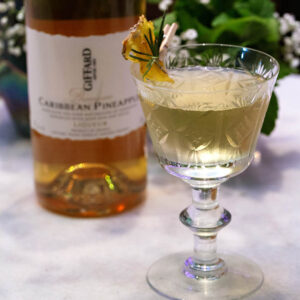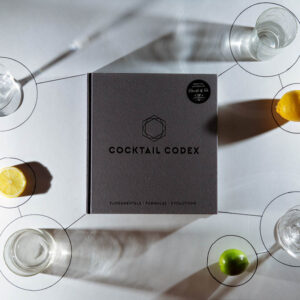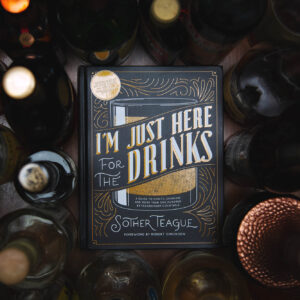It’s Boozy Bookshelf time! Our monthly feature where our friends Marlene and Lucas of Famous Last Words Bar in Toronto review books of a boozy nature. This month, Lucas takes the reigns with Canadian Whisky by Davin de Kergommeaux.
.jpg)
Lucas’s Review:
First, I have to apologize for the solo review this month. We are celebrating our second anniversary at Famous Last Words, and all the changes and preparation meant I couldn’t get Marlene my copy of this month’s book in time for her to review it. It’s entirely my fault, but I promise it wasn’t intentional sabotage. So, to all our loyal readers, I am sorry that you have to put up with my wordy analysis alone.
Canadian Whisky: The New Portable Expert [Second Edition] represents another change of style for our reviews: the spirits guide, rather than a bar technique manual or history book. While it contains quite a bit of history on its titular subject, the book also functions as a quite comprehensive guide about the production and consumption of canadian whisky. I purchased the book from the author himself, Davin de Kergommeaux, at the recent (and wonderful) Toronto Cocktail Conference, run by the amazing team at Bartender Atlas, and was able to have a short chat with the author himself, who is, essentially, a picture-perfect example of a whisky-loving academic. The book itself, while laser-focused on Canadian whisky, is both informative and accessible, and is a pretty great addition to the library for anyone who is interested in the subject or whisk(e)y production in general.
As a Kentucky boy, despite now living in Canada, I have always eyed Canadian whisky with some suspicion, especially as much of the more subpar Canadian product existed as the lowest of low-shelf options in bars and liquor stores after scotch and later bourbon began making their ascendence towards respectability. The first edition of this book, which was published in 2012 and I first encountered at the end of 2013, helped open my eyes a little and encouraged me to branch out and try some of the better Canadian whiskies on the market. Now, finally, Canadian whisky is having a long-deserved moment, with fantastic, high-end product coming out of several distilleries, including Crown’s Northern Harvest, Canadian Club’s ultra-aged releases, and the fantastic Northern Border Rare Release from Wisers that includes my whisk(e)y of the year, Lot 40 Barrel Proof. De Kergommeux couldn’t have timed his second edition better.
Unless one is particularly interested in the history of whisky distilleries and families, the first third of the book will probably be the most useful to the average reader. Mr. de Kergommeaux manages to engage a longtime whisk(e)y nerd like myself with novel information while avoiding being too long-winded or over-technical for a novice. The tone is quite satisfying –Mr. de Kergommeaux is obviously an expert on the scientific end of whisky production but manages to convey the information in such a way that a layperson can find it digestable, and addresses points of production that I hadn’t encountered before. (I remember the “aha!” moment I had when I read the first edition and went over his short section mentioning the additional enzymes necessary for making Canadian whisky, as it made me realize immediately why other books always mentioned bourbon including barley in the mashbill.) The section on blending, while also short, also is essential for understanding the unique processes of Canadian whisky. The third major section of the book, on “enjoying Canadian whisky,” gives a wonderful breakdown on how to taste that can be broadened to tasting any style of whisky, or spirits in general.n>
The sections on the history of the major distilling families and the history and processes of the various distilleries make up the majority of the book, and while they have a lot of information for the curious whisky nerd, they are conveyed in a rather dry and academic manner. The fourth section, “The Concise History of Canadian Whisky,” is probably only a draw for the amateur whisky historian, as it serves more as listing of various important whisky personalities and statistics than a way to offer up sparkling stories and sharp ad copy. The fifth section, on the “Eight Distillers of Canadian Whisky” is misnamed a bit, as there is a ninth chapter on all the smaller producers that have popped up since the first edition. (In fact, the first edition originally had nine chapters, of which one of the distilleries has been folded into the last chapter.) Since Canadian whisky producers haven’t embraced the spirits tourism trend like their American or Scottish counterparts, this chapter is a bit more interesting to the average bartender, as it shows some of the behind-the-scenes details of the different distilleries, allowing for comparing and contrasting their various methods of production.
The layout of the book is clean and quite functional, black-and-white with orange highlights serving as indicators of diagrams or section headings. The diagrams are few but modern and useful, and the photographs are mostly functional. The book contains tasting notes throughout — likely one of the big reasons for the second edition. I tend to subscribe more to the Parker Beam philosophy of whiskey tasting than the elaborate notes from the wine world (the late Heaven Hill master distiller once said, “People say they taste mangoes, and leather. I don’t put mangoes or leather in the whiskey. I put in corn, and I age it in oak barrels, and that’s what I taste: corn and oak!”); as such, I find tasting notes within particular styles to be not tremendously useful, but they are reasonably up to date and useful for anyone who wants to host a tasting or seek out particular profiles. Rounding the book out, it contains a glossary and a pretty solid index of both key terms and the various tasting notes — in short, it is eminently polished, functional, and professional. It does what it wants to do, does it well, is thoroughly researched, avoids too much marketing jargon, and finishes up without too much pontificating, and that alone puts it near the top of spirit books.
Lucas’s Last Word: Canadian Whisky: The New Portable Expert [Second Edition] is a tightly-focused but very approachable look at its subject. It is a must-have for any bartender wanting to specialize in whisky (even, I’d argue, at bars that focus on Scotch or American whiskies, as it details differences in practices), but even they can probably get away with sharing a copy for the bar. For those of us who really are obsessed with whiskey, it serves as a great reference to keep on hand, but if your true love is cocktails or beer it is probably worth thumbing through first.
















